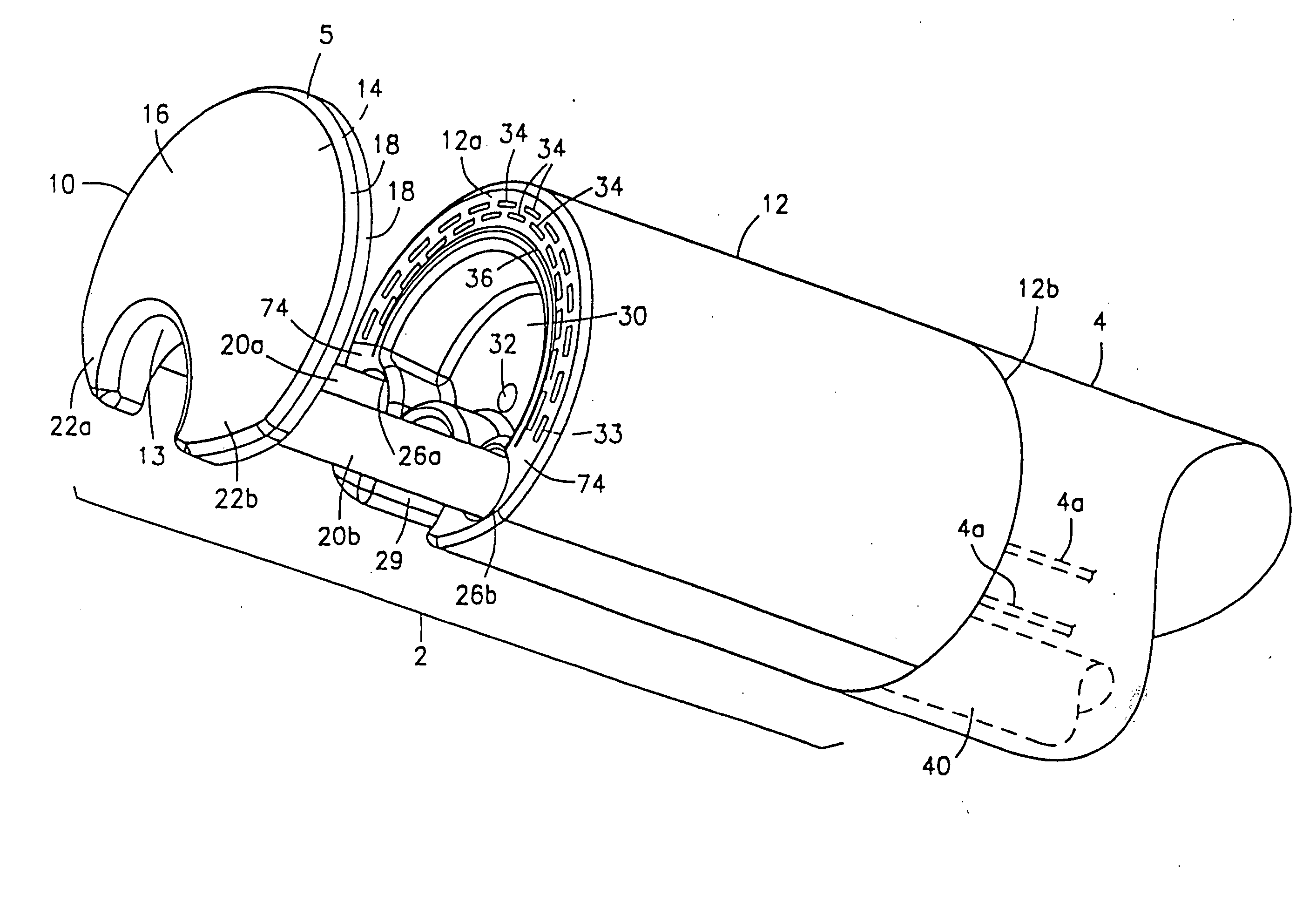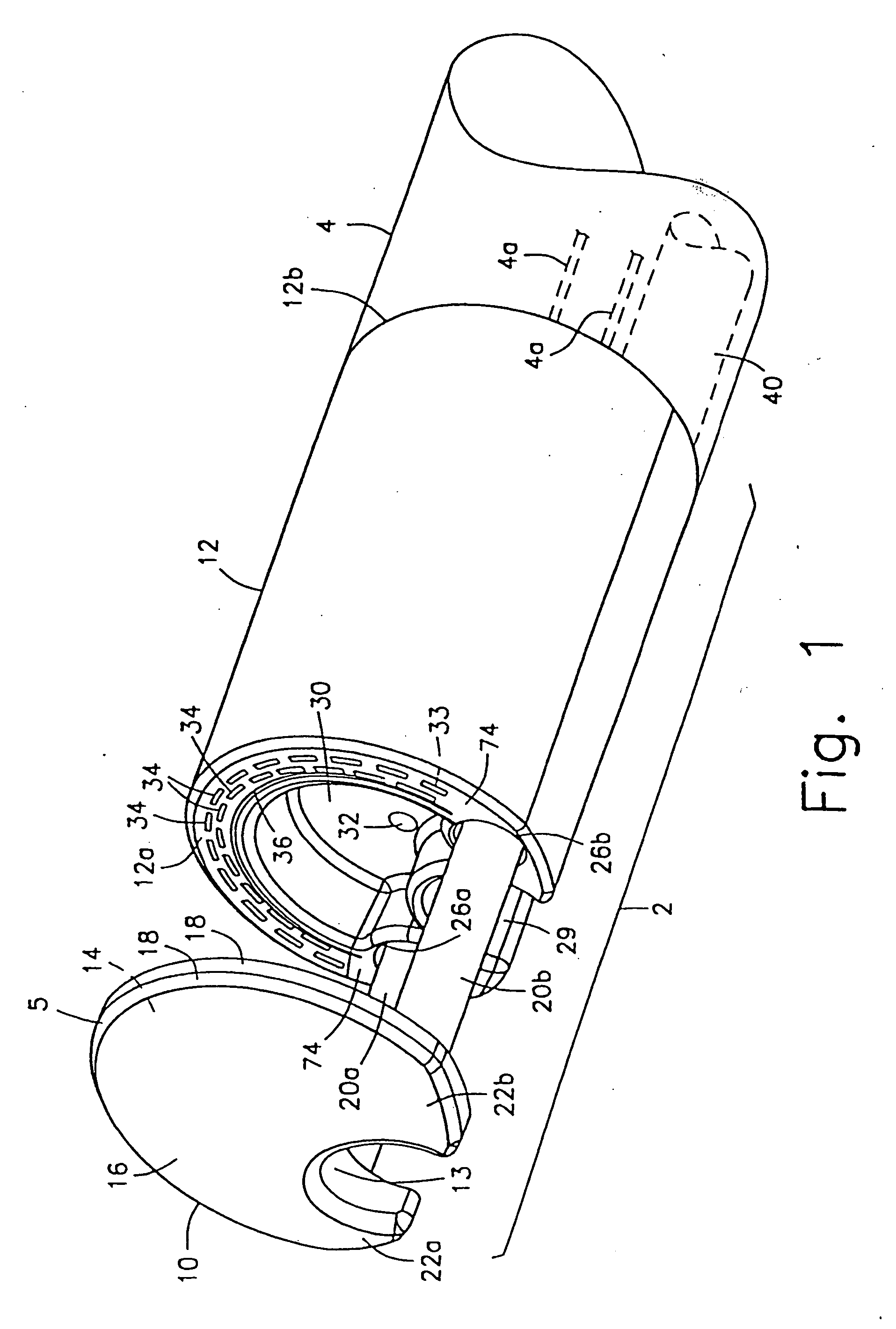Method and device for full thickness resectioning of an organ
a full-thickness resection and organ technology, applied in the direction of surgical staples, surgical forceps, paper/cardboard containers, etc., can solve the problems of long recovery time, partial or complete loss of mobility, and painful incisions,
- Summary
- Abstract
- Description
- Claims
- Application Information
AI Technical Summary
Benefits of technology
Problems solved by technology
Method used
Image
Examples
first embodiment
[0043] As shown in FIGS. 1 and 2, an apparatus according to the present invention comprises a working head assembly 2 which may preferably be connected to a distal end 4a of a sheath 4. The proximal end 4b of the sheath 4 may preferably be connected to a control handle 6.
[0044] In operation, the entire apparatus is mounted onto an endoscope 8 by passing the endoscope 8 through the control handle 6, the sheath 4, and the working head assembly 2, as shown in FIG. 2. The endoscope 8 is then inserted into a body orifice to locate a lesion in the tubular organ under visual observation (usually while insufflating the organ). Once the lesion has been located, the working head assembly 2 and the sheath 4 are slidably advanced along the endoscope 8 into the tubular organ until the working head assembly 2 is in a desired position adjacent to the lesion. Those skilled in the art will understand that in an alternative embodiment, the working head assembly 2 may also be detachably coupled to a d...
second embodiment
[0077]FIG. 11 shows a device according to the present invention in which like reference numerals identify the same elements.
[0078] The anvil member 10 of this embodiment preferably has a substantially circular or elliptical cross-section and is gradually tapered from the proximal face 14 to its distal end 16, forming a bullet-like structure. This tapered shape allows the device to be more easily inserted into the patient's body as the distal end 16 has a smaller cross-sectional size than in the first embodiment. Those skilled in the art will understand that the anvil member 10 may have other tapered shapes besides a bullet-like structure without departing from the scope of the present invention.
[0079] Instead of providing the cut-out 13 shown in the first embodiment to receive the endoscope 8 therein, a substantially cylindrical first endoscope lumen 13 extends axially through the center of the anvil member 10. The distal end 16 of the anvil member 10 may preferably have a beveled ...
third embodiment
[0084]FIG. 12 shows a device according to the present invention. The proximal face 14 of the anvil member 10 of this embodiment has a cross-section similar to the crescent-shaped cross-section of the anvil member 10 of the device of FIG. 1. Thus, the anvil member 10 has two horns 22a and 22b formed on either side of a cut-out 13 which extends axially through the anvil member 10 from the proximal face 14 to the distal end 15 to receive the endoscope 8 therein. As with the device of FIG. 11, the cross-sectional size of the anvil member 10 diminishes in overall size from a maximum at the proximal face 14 to a minimum size at the distal end 15, and the horns 22a and 22b become less pronounced from the proximal face 14 to the distal end 15. In a side view, the anvil member 10 becomes gradually tapered from the proximal end 14 to the distal end 16.
[0085] As in the device of FIG. 11, the tapered shape of the anvil member 10 of the device of FIG. 12 allows for easier insertion of the device...
PUM
| Property | Measurement | Unit |
|---|---|---|
| diameter | aaaaa | aaaaa |
| diameter | aaaaa | aaaaa |
| thickness | aaaaa | aaaaa |
Abstract
Description
Claims
Application Information
 Login to View More
Login to View More - R&D
- Intellectual Property
- Life Sciences
- Materials
- Tech Scout
- Unparalleled Data Quality
- Higher Quality Content
- 60% Fewer Hallucinations
Browse by: Latest US Patents, China's latest patents, Technical Efficacy Thesaurus, Application Domain, Technology Topic, Popular Technical Reports.
© 2025 PatSnap. All rights reserved.Legal|Privacy policy|Modern Slavery Act Transparency Statement|Sitemap|About US| Contact US: help@patsnap.com



